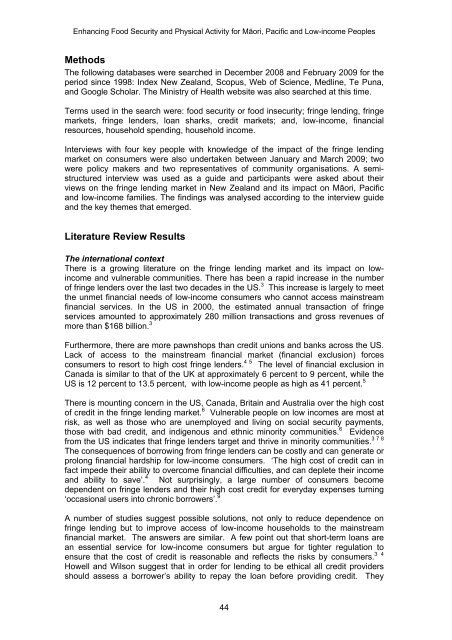enhancing food security and physical activity for maori, pacific and ...
enhancing food security and physical activity for maori, pacific and ...
enhancing food security and physical activity for maori, pacific and ...
- No tags were found...
You also want an ePaper? Increase the reach of your titles
YUMPU automatically turns print PDFs into web optimized ePapers that Google loves.
Enhancing Food Security <strong>and</strong> Physical Activity <strong>for</strong> Māori, Pacific <strong>and</strong> Low-income PeoplesMethodsThe following databases were searched in December 2008 <strong>and</strong> February 2009 <strong>for</strong> theperiod since 1998: Index New Zeal<strong>and</strong>, Scopus, Web of Science, Medline, Te Puna,<strong>and</strong> Google Scholar. The Ministry of Health website was also searched at this time.Terms used in the search were: <strong>food</strong> <strong>security</strong> or <strong>food</strong> in<strong>security</strong>; fringe lending, fringemarkets, fringe lenders, loan sharks, credit markets; <strong>and</strong>, low-income, financialresources, household spending, household income.Interviews with four key people with knowledge of the impact of the fringe lendingmarket on consumers were also undertaken between January <strong>and</strong> March 2009; twowere policy makers <strong>and</strong> two representatives of community organisations. A semistructuredinterview was used as a guide <strong>and</strong> participants were asked about theirviews on the fringe lending market in New Zeal<strong>and</strong> <strong>and</strong> its impact on Māori, Pacific<strong>and</strong> low-income families. The findings was analysed according to the interview guide<strong>and</strong> the key themes that emerged.Literature Review ResultsThe international contextThere is a growing literature on the fringe lending market <strong>and</strong> its impact on lowincome<strong>and</strong> vulnerable communities. There has been a rapid increase in the numberof fringe lenders over the last two decades in the US. 3 This increase is largely to meetthe unmet financial needs of low-income consumers who cannot access mainstreamfinancial services. In the US in 2000, the estimated annual transaction of fringeservices amounted to approximately 280 million transactions <strong>and</strong> gross revenues ofmore than $168 billion. 3Furthermore, there are more pawnshops than credit unions <strong>and</strong> banks across the US.Lack of access to the mainstream financial market (financial exclusion) <strong>for</strong>cesconsumers to resort to high cost fringe lenders. 4 5 The level of financial exclusion inCanada is similar to that of the UK at approximately 6 percent to 9 percent, while theUS is 12 percent to 13.5 percent, with low-income people as high as 41 percent. 5There is mounting concern in the US, Canada, Britain <strong>and</strong> Australia over the high costof credit in the fringe lending market. 6 Vulnerable people on low incomes are most atrisk, as well as those who are unemployed <strong>and</strong> living on social <strong>security</strong> payments,those with bad credit, <strong>and</strong> indigenous <strong>and</strong> ethnic minority communities. 6 Evidencefrom the US indicates that fringe lenders target <strong>and</strong> thrive in minority communities. 3 7 8The consequences of borrowing from fringe lenders can be costly <strong>and</strong> can generate orprolong financial hardship <strong>for</strong> low-income consumers. ‘The high cost of credit can infact impede their ability to overcome financial difficulties, <strong>and</strong> can deplete their income<strong>and</strong> ability to save’. 4 Not surprisingly, a large number of consumers becomedependent on fringe lenders <strong>and</strong> their high cost credit <strong>for</strong> everyday expenses turning‘occasional users into chronic borrowers’. 9A number of studies suggest possible solutions, not only to reduce dependence onfringe lending but to improve access of low-income households to the mainstreamfinancial market. The answers are similar. A few point out that short-term loans arean essential service <strong>for</strong> low-income consumers but argue <strong>for</strong> tighter regulation toensure that the cost of credit is reasonable <strong>and</strong> reflects the risks by consumers. 3 4Howell <strong>and</strong> Wilson suggest that in order <strong>for</strong> lending to be ethical all credit providersshould assess a borrower’s ability to repay the loan be<strong>for</strong>e providing credit. They44
















